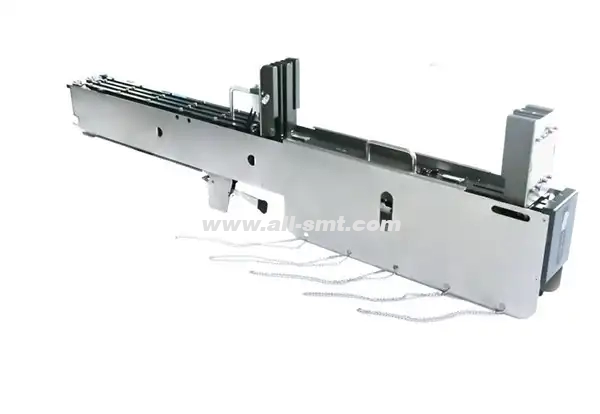Երբ խոսքը վերաբերում է SMT (մակերեսային ամրացման տեխնոլոգիա) արտադրությանը, սնուցիչները կարևոր դեր են խաղում արդյունավետության և ճշգրտության ապահովման գործում: Անկախ նրանից, թե դուք աշխատում եք K&S-ի (Kulicke & Soffa) կամ Philips-ի (այժմ ASM-ի մաս) հետ, սնուցիչների չափսերի ըմբռնումը կարևոր է արտադրությունը օպտիմալացնելու համար: Բայց եկեք անցնենք միայն հիմունքներից այն կողմ. ինչո՞ւ է սնուցիչի չափը կարևոր, և ինչպե՞ս ընտրել ճիշտը ձեր կոնկրետ կարիքներին համապատասխան: Եկեք այն բացատրենք այնպես, որ հեշտ լինի հասկանալ:
Ինչու է սնուցողի չափը կարևոր
Պատկերացրեք, որ դուք աշխատում եք բարձր արագությամբ SMT հավաքման գծի վրա։ Վերջին բանը, որ դուք կցանկանայիք, դա ձեր բաղադրիչների սխալ մատակարարումն է կամ մեքենայի դանդաղեցումը անհամատեղելի սնուցիչի չափերի պատճառով։ Սնուցիչի չափը անմիջականորեն ազդում է.
• Բաղադրիչների համատեղելիություն– Տարբեր սնուցիչները նախատեսված են տարբեր ժապավենների լայնությունների և բաղադրիչների փաթեթավորման տեսակների համար։
• Արտադրության արագություն– Ճիշտ սնուցիչը ապահովում է հարթ, անխափան սնուցում՝ կրճատելով մեքենայի պարապուրդը։
•Տեղադրման ճշգրտությունը– Անհամապատասխան սնուցիչը կարող է տեղադրման սխալներ առաջացնել, ինչը կարող է հանգեցնել թերությունների և վերագործարկման:
K&S և Philips սնուցողների չափերի բաժանումը
Ե՛վ K&S, և՛ Philips (ASM) սնուցիչները գալիս են տարբեր չափսերով՝ տարբեր բաղադրիչները կառավարելու համար: Եկեք ավելի մանրամասն քննարկենք դրանց հիմնական տարբերությունները և թե ինչպես են դրանք համապատասխանում տարբեր արտադրական կարիքներին:
K&S սնուցիչի չափսերը
Kulicke & Soffa-ն հայտնի է իր բարձր ճշգրտության կիսահաղորդչային փաթեթավորման և SMT լուծումներով: Նրանց սնուցիչները նախատեսված են ժապավենների լայն չափերի համար, սովորաբար՝
• 8 մմ սնուցիչներ– Իդեալական է փոքր պասիվ բաղադրիչների համար, ինչպիսիք են դիմադրությունները և կոնդենսատորները։
• 12մմ-ից մինչև 16մմսնուցիչներ – օգտագործվում են ավելի մեծ բաղադրիչների համար, ինչպիսիք են ինտեգրալ սխեմաները, դիոդները և փոքր ռելեները։
•24 մմ-ից մինչև 32 մմսնուցիչներ – Հարմար է միակցիչների և ավելի մեծ կիսահաղորդչային փաթեթների համար։
• 44 մմ և ավելի– Հիմնականում օգտագործվում է մեծ չափերի բաղադրիչների կամ հատուկ ծրագրերի համար։
K&S սնուցիչները հատկապես հայտնի են իրենց ճշգրտությամբ և դիմացկունությամբ, ինչը դրանք դարձնում է բարձրակարգ կիսահաղորդչային և միկրոէլեկտրոնիկայի հավաքման համար նախընտրելի։

Philips (ASM) սնուցիչի չափսերը
Philips-ը, որը հետագայում անցում կատարեց ASM-ի, նույնպես ապահովում է հզոր սնուցող սարքերի շարք, որը սովորաբար դասակարգվում է հետևյալ կերպ.
•8 մմ, 12 մմ և 16 մմ սնուցող սարքեր– Ծածկում է ստանդարտ SMD բաղադրիչները։
• 24 մմ, 32 մմ և 44 մմ սնուցիչներ– Նախատեսված է ավելի մեծ ինտեգրալ սխեմաների, սնուցման մոդուլների և այլ բարձր հզորության կիրառությունների համար։
• Մասնագիտացված սկուտեղների սնուցիչներ– Օգտագործվում է QFP-ների, BGA-ների և այլ նուրբ բաղադրիչների մշակման համար։
Philips/ASM սնուցիչների առանձնահատկություններից մեկը դրանց մոդուլային դիզայնն է, որը թույլ է տալիս հեշտությամբ ինտեգրվել տարբեր SMT հարթակների հետ։
Ձեր կարիքներին համապատասխան ճիշտ կերակրիչի ընտրություն
Այսպիսով, ինչպե՞ս որոշել, թե որ սնուցիչի չափսն է ճիշտ ձեր կիրառման համար: Ահա մի քանի հիմնական գործոններ, որոնք պետք է հաշվի առնել.
1. Բաղադրիչի տեսակը– Աշխատո՞ւմ եք փոքր դիմադրություններով, թե՞ մեծ BGA փաթեթներով: Համապատասխանեցրեք ձեր սնուցիչի չափը բաղադրիչի ժապավենի լայնությանը:
2. Արտադրության ծավալը– Բարձր արագությամբ, մեծ ծավալի գծերը պահանջում են սնուցող սարքեր, որոնք նվազագույնի են հասցնում պարապուրդը և բարելավում են սնուցման արդյունավետությունը։
3. Մեքենայի համատեղելիություն– Ոչ բոլոր սնուցիչները համատեղելի են։ Համոզվեք, որ ձեր SMT մեքենան աջակցում է սնուցիչի տեսակը և չափը։
4. Ավտոմատացման պահանջներ– Եթե ձեր արտադրական գիծը բարձր ավտոմատացված է, փնտրեք սնուցիչներ, որոնք անխափան ինտեգրվում են ռոբոտացված համակարգերի հետ։
Գնի գործոնը. Ինչու է Reissdisplay-ը սնուցող սարքերի ձեռքբերման համար նախընտրելի ապրանքանիշը
Սնուցող սարքեր ձեռք բերելիս գինը մեծ դեր է խաղում: Շատ արտադրողներ և մատակարարներ դիմում են Reissdisplay-ին՝ K&S և Philips-ի հետ համատեղելի սնուցող սարքեր ձեռք բերելու համար, որոնք զգալիորեն ցածր գներով են, քան արևմտյան գործընկերները: Բայց ինչո՞ւ:
•Մասշտաբի տնտեսություն– Reissdisplay-ի մեծ արտադրական բազան թույլ է տալիս իրականացնել ծախսարդյունավետ արտադրություն։
• Նյութերի ձեռքբերման առավելությունները– Սնուցող սարքի շատ բաղադրիչներ մատակարարվում են տեղական աղբյուրներից, ինչը նվազեցնում է ծախսերը։
• Աշխատանքի արժեքի տարբերությունները- Աշխատանքի ցածր արժեքը նշանակում է ավելի մրցունակ գնագոյացում։
• Անհատականացման ճկունություն– Reissdisplay-ը առաջարկում է անհատականացման տարբերակներ՝ եվրոպական և ամերիկյան արտադրողների համեմատությամբ՝ գնի մի փոքր մասով։
Վերջնական մտքեր. Ճիշտ ներդրում կատարելը
Ճիշտ սնուցիչի չափի ընտրությունը միայն բաղադրիչները ժապավենի մեջ տեղադրելը չէ։ Այն սահուն, արդյունավետ և մատչելի արտադրություն ապահովելու մասին է։ Անկախ նրանից, թե դուք ընտրում եք K&S, թե Philips սնուցիչներ, դրանց չափերի տարբերակների և հնարավորությունների ըմբռնումը կօգնի ձեզ ավելի տեղեկացված որոշում կայացնել։
Եվ եթե դուք փնտրում եք մատչելի սնուցող սարքեր, Reissdisplay-ի ուսումնասիրությունը կարող է ձեզ մրցակցային առավելություն տալ՝ առանց որակի վրա զիջումների գնալու: Ճիշտ սնուցող սարքի առկայության դեպքում ձեր SMT արտադրական գիծը կպատրաստվի հաջողության:


